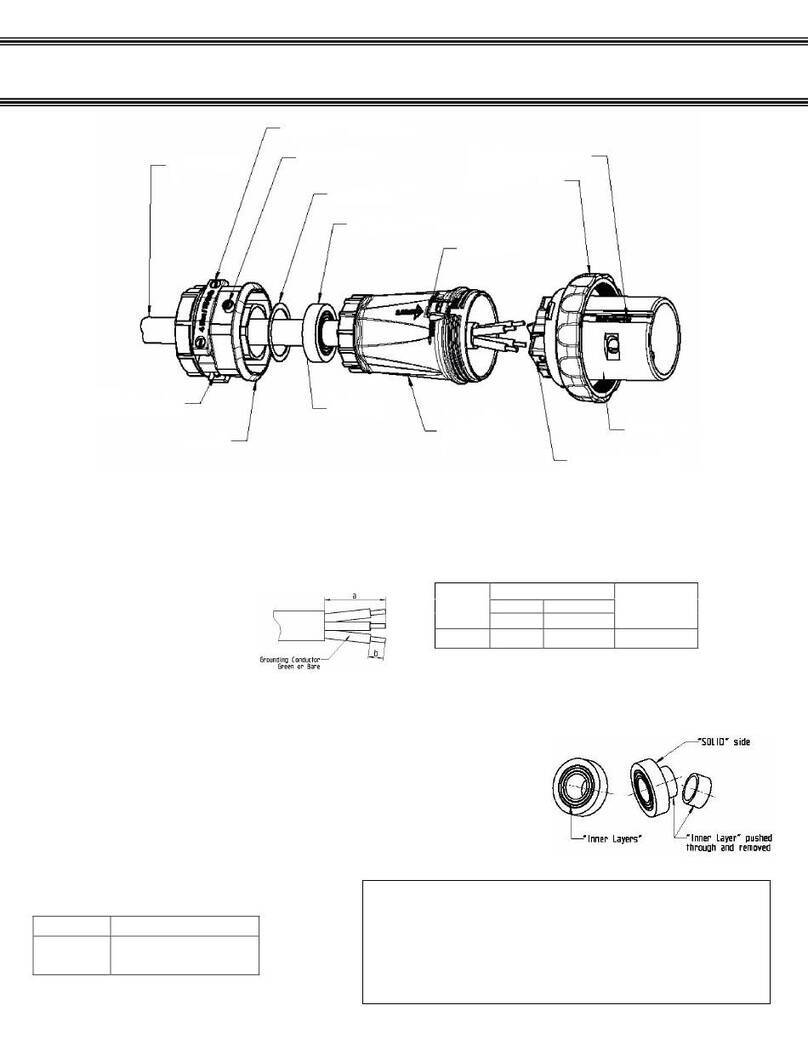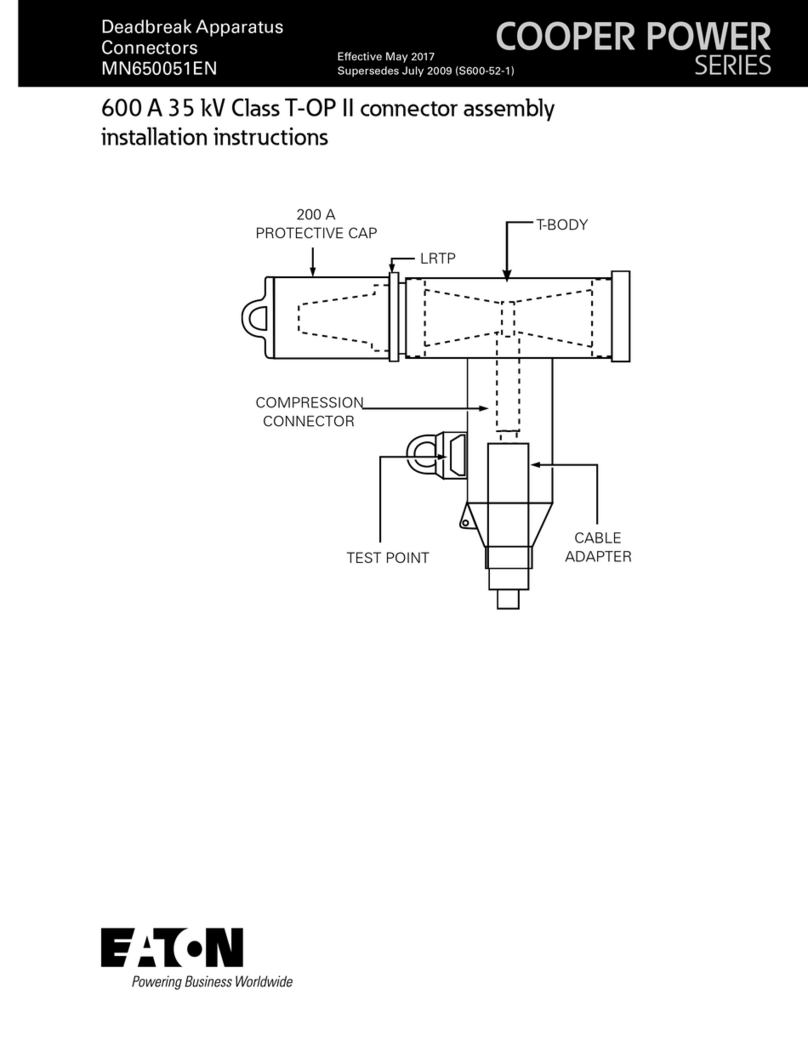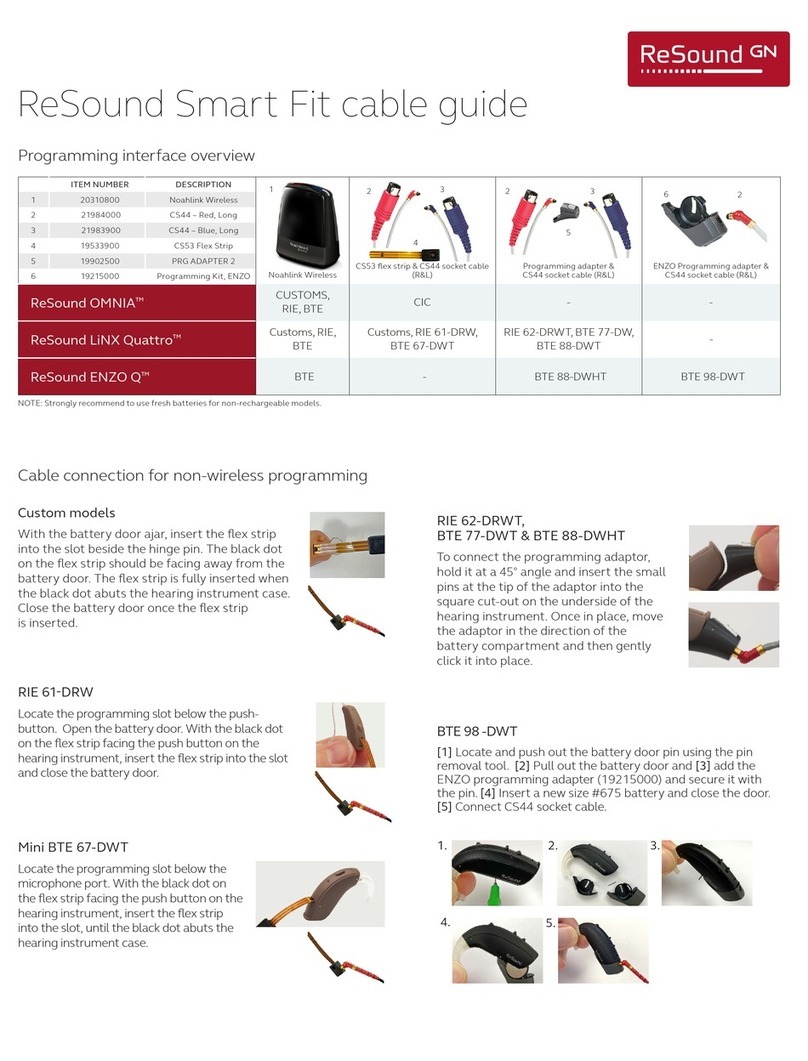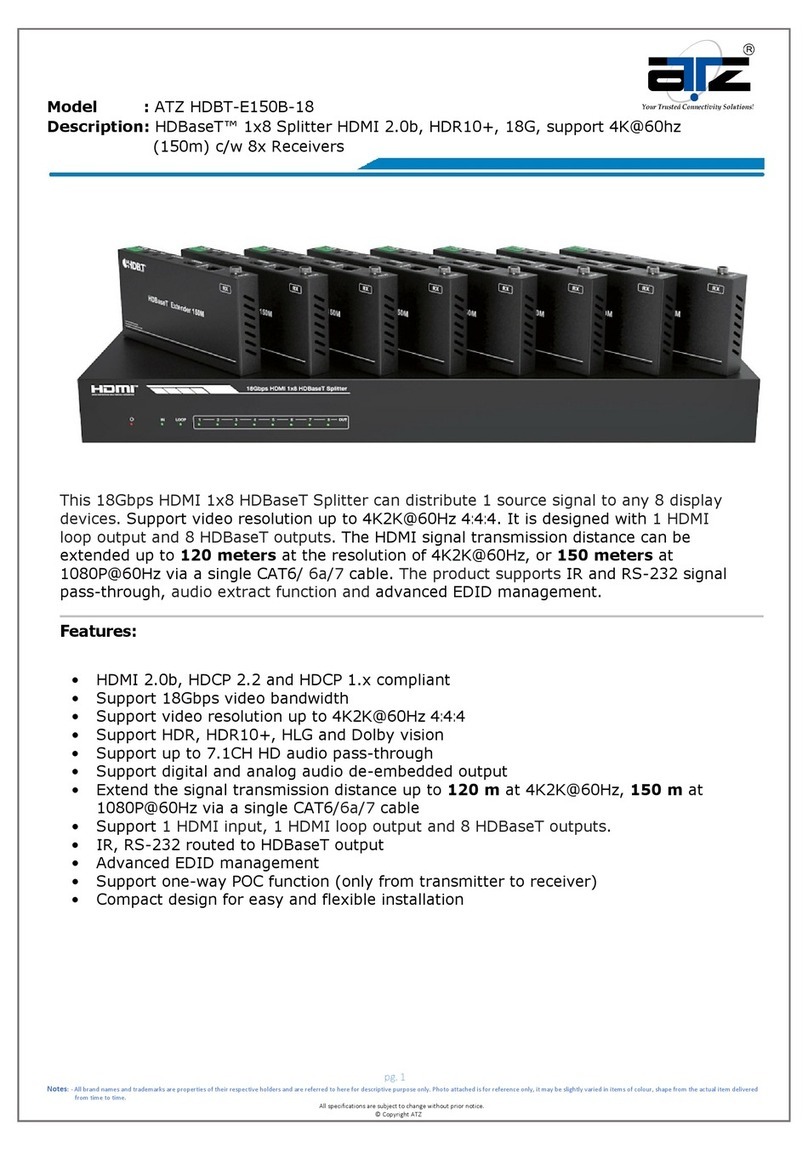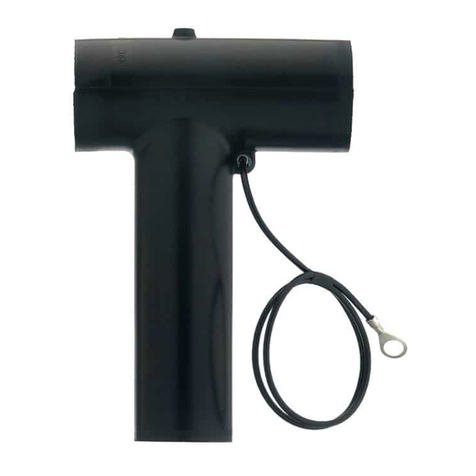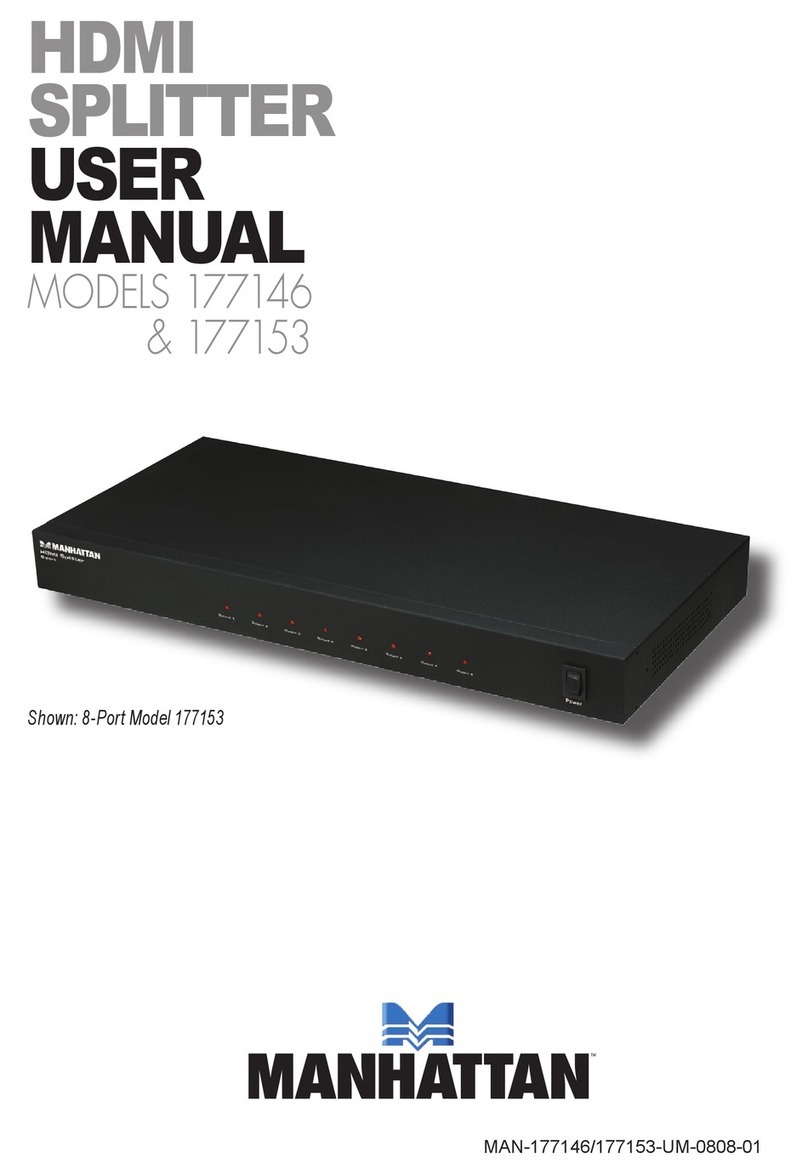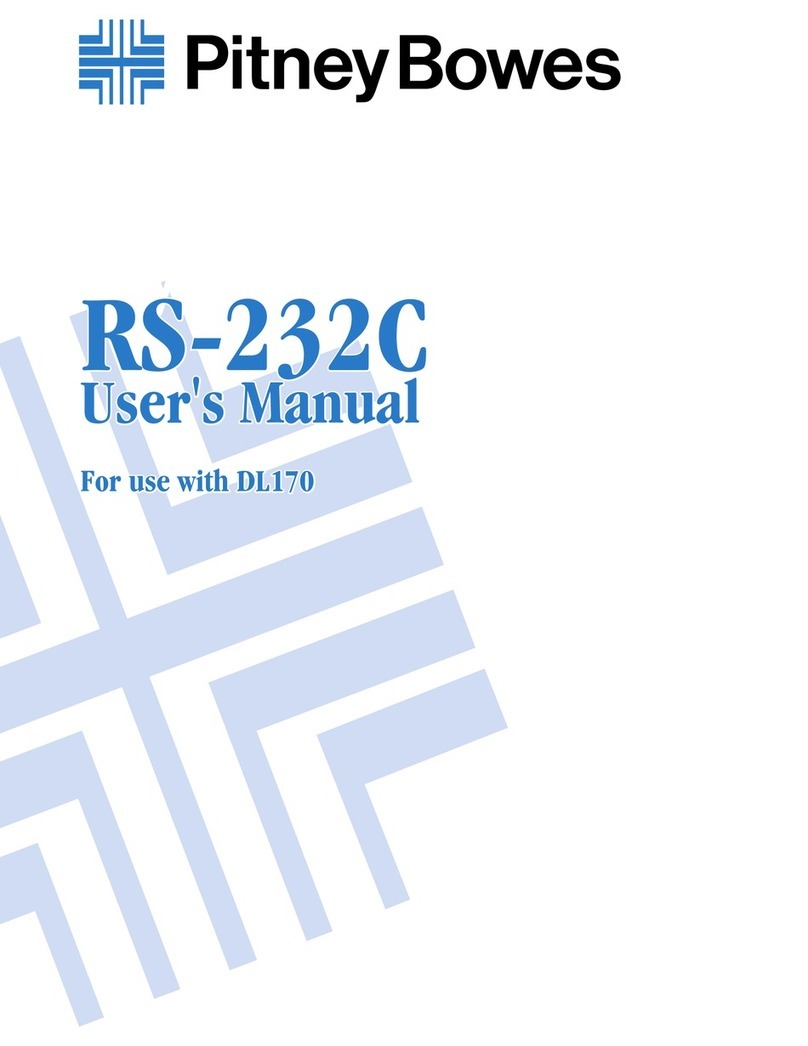Mennekes Mode 2 User manual

Betriebsanleitung
Operating Manual
Manual de instrucciones
Manuel d’utilisation
Istruzioni per l'uso
Manual de Instruções
Manual de utilizare
Gebruiksaanwijzing
Brugsanvisning
Bruksanvisning
Käyttöohje
Bruksanvisning
Οδηγίες χρήσης
Használati utasítás
Kasutusjuhend
Notkunarleiðbeiningar
Instrukcja obsługi
Návod k obsluze
Návod na používanie
Ръководство за работа
Upute za uporabu
Упатство за употреба
Руководство по эксплуатации
Charging cable
Mode 2
Lietošanas instrukcija
Naudojimo instrukcija
Manwal tat-tħaddim
操作手册
İşletim kılavuzu

DE
1
!
!
!
!
!
!
!
!
!
!
!
!
!
!
!
!
!
!
!
!
2
3
1
12
24
Typ 1
Typ GB

5

iv
Publisher: MENNEKES
Stecker GmbH & Co. KG
Aloys-Mennekes-Str. 1
57399 KIRCHHUNDEM
GERMANY
Phone +49 2723 41-612
Fax: +49 2723 41-49612
www.MENNEKES.de
Copyright © 2019 MENNEKES Stecker GmbH & Co. KG
All rights are reserved by the publisher, including the reprinting and the duplication of this manual and its translation, in
whole or in part. No part of this manual may be reproduced in any form whatsoever, or copied with the aid of an electronic
duplication system, without the written permission of the publisher.
Observe protection notice in accordance with DIN ISO 16016. Subject to change without notice.

1
Deutsch........................................... 1
English UK..................................... 5
English US..................................... 8
Español ..........................................11
Español MX..................................14
Français.........................................17
Français CA.................................20
Français LU.................................23
Italiano..........................................26
Português....................................29
Română........................................32
Nederlands .................................35
Nederlands BE...........................38
Dansk.............................................41
Svenska .......................................44
Suomi............................................ 47
Norsk ............................................50
Ελληνικά ......................................53
Magyar .........................................56
Eesti keel.....................................59
Þýska ............................................62
Polski ............................................65
Česky............................................68
Slovensky.....................................71
Български ..................................74
Hrvatski........................................ 77
Македонски...............................80
Русский........................................83
Latviešu........................................86
Lietuviškai....................................89
Malti ..............................................92
德语........................................... 95
Türk...............................................98

2
Grundlegende Sicherheitshinweise
Umschlagblatt beachten – Bild 1.
Die in Bild 1 dargestellten Situationen sind
verboten. Wenn Sie die Situationen nicht ver-
meiden, besteht die Gefahr von Personen- und
Sachschäden.
Kinder vom Ladekabel fernhalten.
Tiere vom Ladekabel fernhalten.
Keine Adapterstecker oder Verlängerungskabel ver-
wenden.
Ladekabel an fehlerfreie und geeignete
Ladeinfrastruktur anschließen.
Steckverbindungen und Steckvorrichtungen vor
Feuchtigkeit und Flüssigkeiten schützen.
Ladekabel nicht in explosionsgefährdeter Umgebung
verwenden, in der sich brennbare Flüssigkeiten, Gase
oder Stäube befinden.
Öffnung zur Entlüftung offen halten.
TACHTUNG
Sachschaden durch Kondenswasser
Bei verschlossener Entlüftung kann das Ladekabel durch
Kondenswasser beschädigt werden (Entlüftung siehe
nachfolgende Abbildung).
fÖffnung stets offen und sauber halten.
fÖffnung nicht verschließen oder bekleben.
fNicht mit Gegenständen in die Löcher stechen.
Abbildung: Öffnung zur Entlüftung auf der
Gehäuseunterseite
Verwendete Symbolik
Das Symbol kennzeichnet einen wichtigen
Hinweis.
Das Symbol kennzeichnet eine zusätzliche, nütz-
liche Information.
Das Symbol kennzeichnet Tätigkeiten, die nur
von einer Elektrofachkraft durchgeführt werden
dürfen.
fDas Symbol kennzeichnet eine Handlungsaufforderung.
Das Symbol kennzeichnet eine Aufzählung.
ÎDas Symbol verweist auf eine andere Stelle in dieser
Betriebsanleitung.
Bestimmungsgemäße Verwendung
Mit dem Ladekabel können Elektro- und Hybridfahrzeuge,
folgend "Fahrzeuge" genannt, an dafür geeigneter
Ladeinfrastruktur aufgeladen werden.
Ladeinfrastruktur im Zweifelsfall durch eine
Elektrofachkraft auf Tauglichkeit prüfen lassen.
Eine andere Verwendung ist nicht zulässig und dadurch
bestimmungswidrig. Das Ladekabel ist nur sicher, wenn
diese Betriebsanleitung und die Dokumentation zum
Fahrzeug beachtet werden.
fVor dem Gebrauch des Ladekabels diese Betriebsanlei-
tung und die Dokumentation zum Fahrzeug lesen.
fWährend dem Gebrauch des Ladekabels die beschrie-
benen Anweisungen beachten.
Nichtbeachten kann zu Personen- oder Sachschäden füh-
ren, wie z.B. elektrischen Schlag, Kurzschluss oder Brand.
Bestimmungswidrige Verwendung
Durch eine bestimmungswidrige Verwendung erhöht sich
das Risiko von Personen- und Sachschäden. Verboten
sind insbesondere:
Ladekabel verändern oder manipulieren.
Ladekabel an fehlerhafte oder ungeeignete
Ladeinfrastruktur anschließen, die z. B. nicht für eine
entsprechende Dauerbelastung ausgelegt ist.
Defektes Ladekabel verwenden.
Für alle Personen- und Sachschäden, die aufgrund bestim-
mungswidriger Verwendung entstehen, ist der Anwender
verantwortlich.
Die MENNEKESSteckerGmbH&Co.KG übernimmt keine
Haftung für Bedienfehler und Schäden, die aus bestim-
mungswidriger Verwendung entstehen.

3
Technische Daten
Die Technischen Daten befinden sich auf dem Typenschild
am Gehäuse.
fTechnische Daten auf dem Typenschild beachten.
fLadekabel nur bis zu einer Höhe von 4.000m über dem
Meeresspiegel verwenden.
Bedienung
TWARNUNG
Beschädigtes Ladekabel – Lebensgefahr durch
Stromschlag
Ein beschädigtes Ladekabel kann zum Tod oder zu schwe-
ren Verletzungen führen.
fLadekabel vor jedem Gebrauch auf Beschädigungen
(z.B. Risse) prüfen.
fBeschädigtes Ladekabel nicht verwenden.
TACHTUNG
Sachschaden durch Brand
Durch zu hohen Ladestrom kann das Ladekabel
beschädigt werden und dadurch ein Brand entstehen.
fMaximal zulässigen Ladestrom im Verwenderland
einhalten.
Maximal zulässiger Ladestrom
Der maximal zulässige Ladestrom beträgt z.B. in
Dänemark 6A und in Finnland oder China 8A.
Ladevorgang starten
Umschlagblatt beachten – Bilder 2, 4 und 5.
fLadekabel abwickeln.
fSchutzkappe vom Stecker auf der Fahrzeugseite ab-
nehmen.
fAuf Bild 2 dargestellte Reihenfolge zum Einstecken des
Ladekabels einhalten.
fLadevorgang am Fahrzeug starten.
Selbsttest-Funktion
Durch die Selbsttest-Funktion des Ladekabels
werden beim Einstecken des Ladekabels in die
Ladeinfrastruktur alle wichtigen Parameter über-
prüft und die Ladung nur dann ermöglicht, wenn
alle Prüfkriterien erfüllt sind.
Zeitweiser Spannungsausfall
Bei zeitweisem Spannungsausfall wird der
Ladevorgang automatisch nach Wiederkehren
der Spannung fortgesetzt.
Ladevorgang beenden
Sobald das Fahrzeug geladen ist, den Ladevorgang
beenden.
Umschlagblatt beachten – Bilder 3 und 4.
Hinweis für Typ GB und Typ 1:
fBeim Ausstecken des Ladekabels Entriege-
lungsknopf drücken.
fLadevorgang am Fahrzeug beenden.
fAuf Bild 3 dargestellte Reihenfolge zum Ausstecken
des Ladekabels einhalten.
fSchutzkappe am Stecker auf der Fahrzeugseite aufste-
cken.
fLadekabel knickfrei aufwickeln.
fLadekabel ordnungsgemäß im Fahrzeug verstauen.
Status der Leuchtdioden (LEDs)
LED 1 LED 2 Status
blinkt blau blinkt blau
Selbsttest-Funktion aktiv.
blinkt
orange
blinkt
orange
blinkt rot blinkt rot
leuchtet
blau aus Kein Fahrzeug angeschlossen.
blinkt blau aus Fahrzeug angeschlossen.
blinkt blau blinkt blau Ladevorgang aktiv.
aus blinkt
orange
Betriebstemperatur kritisch hoch.
9Ladung wird mit reduziertem
Ladestrom fortgesetzt.
Îsiehe 1)
aus leuchtet
orange
Betriebstemperatur überschritten.
9Ladung wird gestoppt.
Îsiehe 1)
aus blinkt rot Fehlerstrom aufgetreten.
blinkt rot leuchtet
rot
Fehler in der Ladeinfrastruktur.
fSchutzleiter (PE) bzw. Ladein-
frastruktur durch Elektrofach-
kraft prüfen lassen.
blinkt
rot im
Wechsel
blinkt
rot im
Wechsel Fehler im Ladekabel.
Îsiehe 2)
leuchtet
rot
leuchtet
rot

4
Um die Fehlermeldungen zurückzusetzen, folgende
Schritte der Reihenfolge nach durchführen:
fLadekabel am Fahrzeug ausstecken.
fLadekabel an der Ladeinfrastruktur ausstecken.
fLadekabel 10 Sekunden ausgesteckt lassen.
fLadekabel an der Ladeinfrastruktur einstecken.
fLadekabel am Fahrzeug einstecken.
1) Störungen durch Temperaturüberschreitung:
fLadekabel vor dem Ladevorgang an einem Ort mit ge-
eigneter Umgebungstemperatur aufbewahren.
fTechnische Daten auf dem Typenschild beachten.
Betriebstemperatur
Das Ladekabel verfügt über ein Steuergerät.
Im Steuergerät befinden sich Sensoren, die
die Betriebstemperaturen im Ladekabel und
im Stecker zur Ladeinfrastruktur überwachen.
Werden die zulässigen Betriebstemperaturen
erreicht, wird die Ladung automatisch mit redu-
ziertem Ladestrom fortgesetzt bzw. die Ladung
wird gestoppt. In diesen Fällen verlängert sich
die Ladezeit.
Betriebstemperatur im Ladekabel
Ladestrom in Ampere [A] Betriebstemperatur ≥ in
Grad Celsius [°C]
maximal reduziert
20
16 +75
13 +80
6+82
16 13 +80
6+82
13 6 +82
8 6 +82
Bei einer Betriebstemperatur unter -40°C oder über
+85°C wird die Ladung gestoppt.
Betriebstemperatur im Stecker zur Ladeinfrastruktur
Bei einer Betriebstemperatur über +50°C wird die Ladung
mit reduziertem Ladestrom von 6A fortgesetzt. Sobald
die Betriebstemperatur wieder unter +45°C ist, wird die
Ladung mit maximalen Ladestrom fortgesetzt. Bei einer
Betriebstemperatur unter -40°C oder über +65°C wird die
Ladung gestoppt.
2) Fehler im Ladekabel.
Werden diese Fehler nicht automatisch
zurückgesetzt, muss das Ladekabel von einer
Elektrofachkraft geprüft bzw. repariert werden.
fBei Fragen Händler kontaktieren.
Reinigung
Je nach Verschmutzung und Einsatzbedingungen kann
das Ladekabel trocken oder feucht gereinigt werden.
TWARNUNG
Berühren von stromführenden Bauteilen – Lebensgefahr
durch Stromschlag
Das Berühren von stromführenden Bauteilen kann zum
Tod oder zu schweren Verletzungen führen.
fLadekabel ausstecken.
fSteckverbindungen und Steckvorrichtungen vor
Feuchtigkeit und Flüssigkeiten schützen.
fKeine Reinigungsmittel verwenden.
fLadekabel mit einem trockenen oder einem leicht mit
Wasser angefeuchteten Tuch reinigen.
Entsorgung
Das Ladekabel darf nicht über den Hausmüll entsorgt wer-
den.
fSammelstellen zum Recycling von elektrischen und
elektronischen Altgeräten nutzen.
fBei Fragen Händler oder Entsorger kontaktieren.

5
Basic safety information
Observe the cover page – Figure 1.
The situations shown in Figure 1 are prohibited. If
you do not avoid these situations, there is a risk
of personal injury and property damage.
Keep children away from the charging cable.
Keep animals away from the charging cable.
Do not use adaptor connectors or extension cables.
Connect the charging cable to functional and suitable
charging infrastructure.
Protect plugs and sockets from moisture and liquids.
Do not use the charging cable in potentially explosive
atmospheres where flammable liquids, gas or dust are
present.
Keep vent opening open.
TATTENTION
Material damage due to condensed water
If the venting is closed, the charging cable may be dam-
aged by condensation (for ventilation, see the Figure
below).
fAlways keep the opening open and clean.
fDo not close or paste over the opening.
fDo not pierce with objects into the holes.
Figure: Opening for ventilation on the housing bottom
Symbols used
This symbol indicates an important note.
This symbol indicates supplemental, useful infor-
mation.
The activities marked with this symbol may only
be carried out by a qualified electrician.
fThis symbol indicates a call for action.
This symbol indicates a listing.
ÎThis symbol is used to refer to another section in this
operation manual.
Intended use
With the charging cable electric and hybrid vehicles,
further referred to as “vehicles”, can be charged at the
appropriate charging infrastructure.
If in doubt, the suitability of the charging infrastruc-
ture must be checked by a qualified electrician.
Any other use is not permitted and is therefore improper.
The charging cable is only safe if this manual and the vehi-
cle documentation are observed.
fRead this operating manual and the vehicle documenta-
tion before using the charging cable.
fWhile using the charging cable, follow the described
instructions.
Failure to do so may result in personal injury or property
damage, such as electric shock, short circuit or fire.
Improper use
An inappropriate use increases the risk of personal injury
and property damage. You are especially not allowed to:
Change or manipulate the charging cable.
Connect the charging cable to faulty or inappropri-
ate charging infrastructure, which, for instance, is not
designed for a corresponding permanent load.
Use a defective charging cable.
The responsibility for all personal injuries and property
damage arising from inappropriate use lies with the user.
MENNEKESSteckerGmbH&Co.KG accepts no liability
for any operation faults or damage arising from improper
use of the device.

6
Technical data
The technical data can be found on the name plate on the
housing.
fObserve the technical data on the name plate.
fOnly use the charging cable up to a height of 4,000m
above sea level.
Operation
TWARNING
Damaged charging cable – Danger to life by electric
shock
A damaged charging cables can result in death or severe
injury.
fCheck the charging cable for damage (e.g. cracks) prior
to every use.
fDo not use damaged charging cable.
TATTENTION
Property damage due to fire
A too high charging current can damage the charging
cable and cause a fire.
fObserve the maximum permissible charging current in
the country of use.
Maximum permissible charging current
The maximum permissible charging current is, for
instance, 6A in Denmark and 8A in Finland or
China.
Starting the charging process
Observe the cover page – Figure 2, 4 and 5.
fUnroll the charging cable.
fRemove the protective cap from the plug on the vehicle
side.
fFor plugging in the charging cable, observe the se-
quence in Figure 2.
fStart charging the vehicle.
Self-test function
The self-test function of the charging cable when
plugging the charging cable into the charging
infrastructure checks all important parameters
and only enables the charge, if all test criteria are
fulfilled.
Temporary power failure
In the case of temporary power failure, the charg-
ing process will be automatically continued after
the voltage is restored.
Terminating the charging process
Once the vehicle has been charged, stop the charging
process.
Observe the cover page – Figure 3 and 4.
Information on type GB and type 1:
fPress the release button when unplugging the
charging cable.
fEnd the charging process on the vehicle.
fFor unplugging in the charging cable, observe the se-
quence in Figure 3.
fPut the protective cap on the plug on the vehicle side.
fWind up the charging cable without kinking.
fStore the charging cable properly in your vehicle.
Status of the light-emitting diodes (LEDs)
LED 1 LED 2 Status
flashes
blue
flashes
blue
Self-test function active.
flashes
orange
flashes
orange
flashes red flashes red
lights up
blue off No vehicle connected.
flashes
blue off Vehicle connected.
flashes
blue
flashes
blue Charging process active.
off flashes
orange
Operating temperature critically
high.
9Charging will be continued with
reduced charging current.
Îsee 1)
off lights up
orange
Operating temperature exceeded.
9Charging will be stopped.
Îsee 1)
off flashes red Fault current occurred.
flashes red lights up
red
Faults in the charging infrastruc-
ture.
fHave protective conductor
(PE) or charging infrastructure
checked by a qualified electri-
cian.
flashes red
alternately
flashes red
alternately Errors in the charging cable.
Îsee 2)
lights up
red
lights up
red

7
To reset the error messages, perform the following steps
in sequence:
fUnplug charging cable from the vehicle.
fUnplug charging cable from the charging infrastructure.
fKeep the charging cable unplugged for 10 seconds.
fPlug charging cable in the charging infrastructure.
fPlug charging cable in the vehicle.
1) Fault caused by excess temperature:
fBefore the charging process, store the charging cable
at a place with suited ambient temperature.
fObserve the technical data on the name plate.
Operating temperature
The charging cable has a control unit. The control
unit contains sensors that monitor the operating
temperatures in the charging cable and the plug
for charging infrastructure. Once the permissible
operating temperatures have been reached, the
charging will be automatically continued with
reduced charging current or the charging will be
stopped. In these cases, the charging time will be
extended.
Operating temperature in the charging cable
Charging current in
amperes [A]
Operating temperature ≥
in degrees Celsius [°C]
maximum reduced
20
16 +75
13 +80
6+82
16 13 +80
6+82
13 6 +82
8 6 +82
At an operating temperature below -40°C or above
+85°C, the charging will be stopped.
Operating temperature in the plug to the charging infra-
structure
At an operating temperature above +50°C, the charging
will continue with a reduced charging current of 6A. Once
the operating temperature is below +45°C again, the
charging will be continued with the maximum charging cur-
rent. At an operating temperature below -40°C or above
+65°C, the charging will be stopped.
2) Errors in the charging cable.
If these errors are not automatically reset, the
charging cable must be checked and repaired by
a qualified electrician.
fIf you have questions, contact your dealer.
Cleaning
The charging cable can be cleaned with a dry or damp
cloth, depending on application conditions and soiling.
TWARNING
Contact with live parts – Life-threatening danger due to
electric shock
Touching live components can lead to death or serious
injuries.
fUnplug charging cable.
fProtect plugs and sockets from moisture and liquids.
fDo not use cleaning agents.
fClean the charging cable with a dry cloth or a cloth
moistened with water.
Disposal
The charging cable must not be disposed with household
waste.
fUse a collection point for recycling electrical and elec-
tronic appliances.
fIf you have questions, contact the dealer or waste dis-
posal company.

8
Basic Safety Instructions
Please take note of and follow the information
on the cover page – Figure 1.
The situations shown in Figure 1 are prohibited. If
you do not avoid these situations, there is a risk
of personal injury and property damage.
Keep children away from the charging cable.
Keep animals away from the charging cable.
Do not use adapter plugs or extension cables.
Connect the charging cable to a correctly functioning
and suitable EV charging station.
Protect plugs and receptacles from moisture and liq-
uids.
Do not use the charging cable in potentially explosive
atmospheres where flammable liquids, gas or dust are
present.
Keep vent opening open.
TATTENTION
Material damage due to condensation
If the vent is closed, condensation can result in damage to
the charging cable (for ventilation, see the Figure below).
fAlways keep the opening open and clean.
fDo not close or cover the opening.
fDo not pierce objects into the holes.
Figure: Opening for ventilation on the housing bottom
Technical data
The technical data can be found on the rating plate on the
housing.
fCompliance with the technical data on the rating plate is
required.
fOnly use the charging cable up to an altitude of
4,000m above sea level.
Symbols used
This symbol indicates an important note.
This symbol is used to point out supplemental,
useful information.
The activities marked with this symbol may only
be carried out by a qualified electrician.
fThis symbol is used to point out a call for action.
This symbol indicates a listing.
ÎThis symbol is used to refer to another section in this
operation manual.
Intended use
Electric and hybrid vehicles, hereinafter referred to as
“vehicles”, can be charged using this charging cable at an
appropriate electric vehicle (EV) charging station.
If in doubt, have a qualified electrician check the
EV charging station for suitability.
Any other use is not permissible and regarded as improper
use. This charging cable is only safe to use, provided the
instructions in this manual and the vehicle documentation
are followed.
fRead this operating manual and the vehicle documenta-
tion before using this charging cable.
fWhenever you use this charging cable, follow the pro-
vided instructions.
Failure to do so may result in personal injury or property
damage, electric shock, short circuit or fire.
Improper use
Inappropriate use increases the risk of personal injury and
property damage. You are specifically not permitted to:
Make changes to or tamper with the charging cable.
Connect the charging cable to a flawed or inappro-
priate EV charging station, which, for instance, is not
designed for the required permanent load.
Use a defective charging cable.
The user is responsible for any personal injury or property
damage arising from inappropriate use.
MENNEKESSteckerGmbH&Co.KG shall not be held
liable for any operating faults or damage as a result of the
improper use of the device.

9
Operation
TWARNING
Damaged charging cable – Danger to life due to electric
shock
A damaged charging cable can result in death or severe
injury.
fCheck the charging cable for damage (e.g. cracks) prior
to each use.
fDo not use a damaged charging cable.
TATTENTION
Property damage due to fire
Too high of a charging current could damage the charging
cable and cause a fire.
fCompliance with maximum permissible charging cur-
rent in the country of use is required.
Maximum permissible charging current
The maximum permissible charging current is, for
instance, 6A in Denmark and 8A in Finland or
China.
Starting the charging process
Please take note of and follow the information
on the cover page – Figures 2, 4 and 5.
fUnroll the charging cable.
fRemove the protective cap from the plug on the vehicle.
fFor plugging in the charging cable, follow the sequence
shown in Figure 2.
fStart the vehicle charging process.
Self-test function
The self-test function of the charging cable is used
for checking all essential parameters when plugging
the charging cable into the EV charging station,
enabling charging only if all test criteria are fulfilled.
Temporary power failure
In the case of a temporary power failure, the
charging process automatically resumes, once
power is restored.
Completing the charging process
Once the vehicle is fully charged, stop the charging
process.
Please take note of and follow the information
on the cover page – Figures 3 and 4.
Information on type GB and type 1:
fPress the release button to unplug the
charging cable.
fFinish the vehicle charging process.
fTo unplug the charging cable, follow the sequence
shown in Figure 3.
fPut the protective cap back on the plug on the vehicle.
fProperly roll the charging cable so that there are no
kinks.
fProperly store the charging cable in your vehicle.
Status of light-emitting diodes (LEDs)
LED 1 LED 2 Status
Flashing
blue
Flashing
blue
Self-test function active.
Flashing
orange
Flashing
orange
Flashing
red
Flashing
red
Lights up
blue Off No vehicle connected
Flashing
blue Off Vehicle connected
Flashing
blue
Flashing
blue Charging process in progress
Off Flashing
orange
Critically high operating tempera-
ture.
9Charging process continues
with reduced charging current
Îsee 1)
Off Lights up
orange
Operating temperature exceeded.
9Charging is stopped:
Îsee 1)
Off Flashing
red Fault current occurred.
Flashing
red
Lights up
red
Fault with EV charging station
infrastructure.
fHave protective ground con-
ductor (PE) or charging station
infrastructure checked by a
qualified electrician.
Flashing
red
alternately
Flashing
red
alternately Fault with the charging cable.
Îsee 2)
Lights up
red
Lights up
red

10
To reset and clear the error messages, perform the steps
below in the given order:
fUnplug charging cable from vehicle.
fUnplug charging cable from charging station.
fKeep charging cable unplugged for 10 seconds.
fPlug charging cable back into charging station.
fPlug charging cable back into vehicle.
1) Fault due to excess temperature:
fBefore commencing the charging process ensure that
the charging cable has been stored at a place with an
appropriate ambient temperature.
fCompliance with the technical data on the rating plate is
required.
Operating temperature
The charging cable is equipped with a control
system. The control system has sensors to moni-
tor the operating temperature within the charging
cable and the plug to the charging station. On
reaching the permissible operating temperature,
the charging process automatically continues
at a reduced charging current or the charging
process is stopped. If this is the case, it will take
longer to complete the charging process.
Charging cable operating temperature
Charging current in
amperes [A]
Operating temperature ≥
in degrees Celsius [°C]
Maximum Reduced
20
16 +75
13 +80
6+82
16 13 +80
6+82
13 6 +82
8 6 +82
At an operating temperature of -40°C or +85°C, the
charging process is stopped.
Operating temperature of plug to the charging station
At an operating temperature above +50°C, the charging
process continues at a reduced charging current of 6A.
Once the operating temperature is below +45°C again, the
charging process continues at the maximum charging cur-
rent. At an operating temperature below -40°C or above
+65°C, the charging process is stopped.
2) Faults with the charging cable.
If these faults are not automatically reset, the
charging cable must be checked and repaired by
a qualified electrician.
fContact your dealer if you have any questions.
Cleaning
The charging cable can be cleaned with a dry or damp
cloth, depending on application conditions and soiling.
TWARNING
Contact with live parts – Life-threatening danger due to
electric shock
Touching live components can result in death or severe
injury.
fUnplug charging cable.
fProtect plugs and receptacles from moisture and liquids.
fDo not use cleaning agents.
fClean the charging cable with a dry cloth or a cloth
moistened with water.
Disposal
The charging cable must not be discarded with household
waste.
fTake electrical and electronic appliances to a recycable
waste collection center.
fIf you have questions, contact your dealer or the waste
disposal company.

11
Indicaciones básicas de seguridad
Observe la cubierta – Imagen 1.
Quedan prohibidas las situaciones representa-
das en la figura 1. En caso de que no evite estas
situaciones, existe peligro de daños personales y
materiales.
Mantenga a los niños alejados del cable de carga.
Mantenga a los animales alejados del cable de carga.
No utilice clavijas adaptadoras ni cables alargadores.
Conecte el cable de carga en infraestructura de carga
que no presente fallos y sea adecuada.
Proteja los conectores y dispositivos de conexión de la
humedad y líquidos.
No utilice el cable de carga en entornos explosivos en
los que haya líquidos, gases o polvos combustibles.
Mantenga abierta la abertura para la purga.
TATENCIÓN
Daños materiales por el agua de condensación
En caso de que la purga esté cerrada, el cable de carga
podría resultar dañado a causa del agua condensada (para
la purga véase la siguiente figura).
fMantenga siempre la abertura abierta y limpia.
fNo cierre ni cubra la abertura.
fNo clave objetos en los orificios.
Figura: Abertura para la purga en la parte inferior de la
carcasa
Datos técnicos
Los datos técnicos se hallan en la placa de características
de la carcasa.
fObserve los datos técnicos de la placa de característi-
cas.
fUtilice el cable de carga únicamente hasta una altura de
4000m sobre el nivel del mar.
Símbolos utilizados
Este símbolo indica información importante.
Este símbolo indica información útil adicional.
Este símbolo indica actividades que únicamente
deben ser realizadas por un técnico electricista.
fEste símbolo indica un procedimiento.
Este símbolo indica una enumeración.
ÎEste símbolo remite a otra parte del presente manual
de instrucciones.
Uso conforme a lo previsto
Con el cable de carga pueden cargarse vehículos eléctri-
cos e híbridos, en lo sucesivo denominados “vehículos”,
en la infraestructura de carga adecuada para ello.
En caso de duda, solicite a un técnico electricista
que revise la idoneidad de la infraestructura de
carga.
Cualquier otro uso no está permitido y se considera inco-
rrecto. El cable de carga solo es seguro si se observan
este manual de instrucciones y la documentación sobre el
vehículo.
fLea este manual de instrucciones y la documentación
sobre el vehículo antes de utilizar el cable de carga.
fMientras utilice el cable de carga tenga en cuenta las
instrucciones descritas.
La no observación puede provocar daños personales o
materiales, p. ej. descarga eléctrica, cortocircuito o incendio.
Uso inadecuado
El uso inadecuado aumenta el riesgo de que se produzcan
lesiones personales y daños materiales. Queda especial-
mente prohibido:
Modificar o manipular el cable de carga.
Conectar el cable de carga en infraestructura de carga
defectuosa o inadecuada, que p. ej. no se haya diseña-
da para una carga continua correspondiente.
Utilizar un cable de carga defectuoso.
El usuario será responsable de los daños personales y
materiales derivados de un uso inadecuado.
MENNEKESSteckerGmbH&Co.KG no se hace respon-
sable de los fallos de manejo y daños derivados de un uso
inadecuado.

12
Operación
TADVERTENCIA
Peligro de muerte por descarga eléctrica si el cable de
carga está dañado
Un cable de carga dañado puede provocar lesiones gra-
ves o incluso la muerte.
fAntes de utilizar el cable de carga, verifique siempre
que no esté dañado (p. ej. fisuras).
fNo utilice el cable de carga si está dañado.
TATENCIÓN
Daños materiales a causa de incendio
Debido a una corriente de carga demasiado elevada, el cable
de carga puede dañarse y de ahí producirse un incendio.
fRespete la corriente de carga máxima admisible en el
país de uso.
Corriente de carga máxima admisible
La corriente de carga máxima admisible es p. ej.
en Dinamarca de 6A y en Finlandia o China de
8A.
Empezar el proceso de carga
Observe la cubierta – Figuras 2, 4 y 5.
fDesenrolle el cable de carga.
fRetire la tapa protectora del conector en el lado del
vehículo.
fMantenga la secuencia representada en la figura 2 para
la conexión del cable de carga.
fInicie el proceso de carga en el vehículo.
Función de autotest
Mediante la función de autotest del cable de
carga, al conectar el cable de carga en la infraes-
tructura de carga se comprueban todos los pará-
metros importantes y solo se permite la carga si
se cumplen todos los criterios de prueba.
Fallo de tensión temporal
En caso de un fallo de tensión temporal, al regre-
sar la tensión el proceso de carga se reanudará
automáticamente.
Finalizar el proceso de carga
En cuanto el vehículo esté cargado, finalice el proceso
de carga.
Observe la cubierta – Figuras 3 y 4.
Indicación para el tipo GB y el tipo 1:
fAl desenchufar el cable de carga, pulse el bo-
tón de desbloqueo.
fFinalice el proceso de carga en el vehículo.
fMantenga la secuencia representada en la figura 3 para
la desconexión del cable de carga.
fColoque la tapa protectora en el conector en el lado del
vehículo.
fEnrolle el cable de carga sin dobleces.
fGuarde el cable de carga correctamente en el vehículo.
Estado de los diodos luminosos (LED)
LED 1 LED 2 Estado
azul inter-
mitente
azul inter-
mitente
Función de autotest activada.
naranja
intermi-
tente
naranja
intermi-
tente
rojo inter-
mitente
rojo inter-
mitente
encendido
en azul apagado Ningún vehículo conectado.
azul inter-
mitente apagado Vehículo conectado.
azul inter-
mitente
azul inter-
mitente Proceso de carga activo.
apagado
naranja
intermi-
tente
Temperatura de funcionamiento
críticamente alta.
9La carga continúa con corrien-
te de carga reducida.
Îvéase 1)
apagado encendido
en naranja
Temperatura de funcionamiento
excedida.
9La carga se detiene.
Îvéase 1)
apagado rojo inter-
mitente
Se ha producido un fallo de
corriente.
rojo
intermi-
tente
encendido
en rojo
Fallo en la infraestructura de
carga.
fEncargue la revisión del con-
ductor de protección (PE) y/o
la infraestructura de carga a
un técnico electricista.
rojo inter-
mitente en
alternan-
cia
rojo inter-
mitente en
alternan-
cia Fallo en el cable de carga.
Îvéase 2)
encendido
en rojo
encendido
en rojo

13
Para restablecer los mensajes de error, lleve a cabo los
siguientes pasos de la secuencia:
fDesenchufe el cable de carga del vehículo.
fDesenchufe el cable de carga en la infraestructura.
fDeje el cable de carga 10 segundos desenchufado.
fEnchufe el cable de carga en la infraestructura.
fEnchufe el cable de carga en el vehículo.
1) Averías debido a un exceso de temperatura:
fAntes del proceso de carga guarde el cable de carga
en un lugar adecuado a una temperatura ambiente ade-
cuada.
fObserve los datos técnicos de la placa de característi-
cas.
Temperatura de funcionamiento
El cable de carga dispone de un equipo de
mando. En el equipo de mando hay sensores
que supervisan las temperaturas de funciona-
miento en el cable de carga y en el conector
para la infraestructura de carga. En caso de
alcanzarse las temperaturas de funcionamiento
admisibles, la carga continúa automáticamente
con corriente de carga reducida o bien se detie-
ne la carga. En estos casos, se prolonga el tiem-
po de carga.
Temperatura de funcionamiento en el cable de carga
Corriente de carga en
amperios [A]
Temperatura de
funcionamiento ≥ en
grados centígrados [°C]
máxima reducida
20
16 +75
13 +80
6+82
16 13 +80
6+82
13 6 +82
8 6 +82
Con una temperatura de funcionamiento inferior a -40°C o
por encima de +85°C se detiene la carga.
Temperatura de funcionamiento en el conector para la
infraestructura de carga
Con una temperatura de funcionamiento superior a
+50°C, la carga continúa con una corriente de carga redu-
cida de 6A. En cuanto la temperatura de funcionamiento
vuelve a hallarse por debajo de +45°C, la carga continúa
con corriente de carga máxima. Con una temperatura de
funcionamiento inferior a -40°C o por encima de +65°C
se detiene la carga.
2) Fallo en el cable de carga.
En caso de que estos fallos no se restauren auto-
máticamente, un técnico electricista deberá com-
probar y/o reparar el cable de carga.
fEn caso de preguntas, consulte al proveedor.
Limpieza
Dependiendo de la suciedad y de las condiciones de uso,
el cable de carga puede limpiarse en seco o con líquidos.
TADVERTENCIA
Contacto con los componentes cargados con corriente
eléctrica – Peligro de muerte por descarga eléctrica
Al tocar los componentes conductores de corriente existe
peligro de sufrir lesiones graves o incluso mortales.
fDesenchufe el cable de carga.
fProteja los conectores y dispositivos de conexión de la
humedad y líquidos.
fNo emplee productos de limpieza.
fLimpie el cable de carga con un paño seco o ligeramen-
te humedecido con agua.
Eliminación
El cable de carga no debe desecharse con la basura
doméstica.
fUtilice centros de recogida y reciclaje de aparatos eléc-
tricos y electrónicos usados.
fEn caso de preguntas, consulte al proveedor o al res-
ponsable de la eliminación.

14
Indicaciones básicas de seguridad
Observe la cubierta – Imagen 1.
Quedan prohibidas las situaciones representa-
das en la figura 1. En caso de que no evite estas
situaciones, existe peligro de daños personales y
materiales.
Mantenga a los niños alejados del cable de carga.
Mantenga a los animales alejados del cable de carga.
No utilice clavijas adaptadoras ni cables alargadores.
Conecte el cable de carga en infraestructura de carga
que no presente fallos y sea adecuada.
Proteja los conectores y dispositivos de conexión de la
humedad y líquidos.
No utilice el cable de carga en entornos explosivos en
los que haya líquidos, gases o polvos combustibles.
Mantenga abierta la abertura para la purga.
TATENCIÓN
Daños materiales por el agua de condensación
En caso de que la purga esté cerrada, el cable de carga
podría resultar dañado a causa del agua condensada (para
la purga véase la siguiente figura).
fMantenga siempre la abertura abierta y limpia.
fNo cierre ni cubra la abertura.
fNo clave objetos en los orificios.
Figura: Abertura para la purga en la parte inferior de la
carcasa
Datos técnicos
Los datos técnicos se hallan en la placa de características
de la carcasa.
fObserve los datos técnicos de la placa de características.
fUtilice el cable de carga únicamente hasta una altura de
4000m sobre el nivel del mar.
Símbolos utilizados
Este símbolo indica información importante.
Este símbolo indica información útil adicional.
Este símbolo indica actividades que únicamente
deben ser realizadas por un técnico electricista.
fEste símbolo indica un procedimiento.
Este símbolo indica una enumeración.
ÎEste símbolo remite a otra parte del presente manual
de instrucciones.
Uso conforme a lo previsto
Con el cable de carga pueden cargarse vehículos eléctri-
cos e híbridos, en lo sucesivo denominados "vehículos",
en la infraestructura de carga adecuada para ello.
En caso de duda, solicite a un técnico electricista
que revise la idoneidad de la infraestructura de
carga.
Cualquier otro uso no está permitido y se considera inco-
rrecto. El cable de carga solo es seguro si se observan
este manual de instrucciones y la documentación sobre el
vehículo.
fLea este manual de instrucciones y la documentación
sobre el vehículo antes de utilizar el cable de carga.
fMientras utilice el cable de carga tenga en cuenta las
instrucciones descritas.
La no observación puede provocar daños personales o
materiales, p. ej. descarga eléctrica, cortocircuito o incendio.
Uso inadecuado
El uso inadecuado aumenta el riesgo de que se produzcan
lesiones personales y daños materiales. Queda especial-
mente prohibido:
Modificar o manipular el cable de carga.
Conectar el cable de carga en infraestructura de carga
defectuosa o inadecuada, que p. ej. no se haya diseña-
da para una carga continua correspondiente.
Utilizar un cable de carga defectuoso.
El usuario será responsable de los daños personales y
materiales derivados de un uso inadecuado.
MENNEKESSteckerGmbH&Co.KG no se hace respon-
sable de los fallos de manejo y daños derivados de un uso
inadecuado.

15
Operación
TADVERTENCIA
Peligro de muerte por descarga eléctrica si el cable de
carga está dañado
Un cable de carga dañado puede provocar lesiones gra-
ves o incluso la muerte.
fAntes de utilizar el cable de carga, verifique siempre
que no esté dañado (p. ej. fisuras).
fNo utilice el cable de carga si está dañado.
TATENCIÓN
Daños materiales a causa de incendio
Debido a una corriente de carga demasiado elevada, el
cable de carga puede dañarse y de ahí producirse un
incendio.
fRespete la corriente de carga máxima admisible en el
país de uso.
Corriente de carga máxima admisible
La corriente de carga máxima admisible es p. ej. en
Dinamarca de 6A, y en Finlandia o China de 8A.
Empezar el proceso de carga
Observe la cubierta – Figuras 2, 4 y 5.
fDesenrolle el cable de carga.
fRetire la tapa protectora del conector en el lado del
vehículo.
fMantenga la secuencia representada en la figura 2 para
la conexión del cable de carga.
fInicie el proceso de carga en el vehículo.
Función de autotest
Mediante la función de autotest del cable de
carga, al conectar el cable de carga en la infraes-
tructura de carga se comprueban todos los pará-
metros importantes y solo se permite la carga si
se cumplen todos los criterios de prueba.
Fallo de tensión temporal
En caso de un fallo de tensión temporal, al regre-
sar la tensión el proceso de carga se reanudará
automáticamente.
Finalizar el proceso de carga
En cuanto el vehículo esté cargado, finalice el proceso
de carga.
Observe la cubierta – Figuras 3 y 4.
Indicación para el tipo GB y el tipo 1:
fAl desenchufar el cable de carga, pulse el bo-
tón de desbloqueo.
fFinalice el proceso de carga en el vehículo.
fMantenga la secuencia representada en la figura 3 para
la desconexión del cable de carga.
fColoque la tapa protectora en el conector en el lado del
vehículo.
fEnrolle el cable de carga sin dobleces.
fGuarde el cable de carga correctamente en el vehículo.
Estado de los diodos luminosos (LED)
LED 1 LED 2 Estado
azul inter-
mitente
azul inter-
mitente
Función de autotest activada.
naranja
intermi-
tente
naranja
intermi-
tente
rojo inter-
mitente
rojo inter-
mitente
encendido
en azul apagado Ningún vehículo conectado.
azul inter-
mitente apagado Vehículo conectado.
azul inter-
mitente
azul inter-
mitente Proceso de carga activo.
apagado
naranja
intermi-
tente
Temperatura de funcionamiento
críticamente alta.
9La carga continúa con corrien-
te de carga reducida.
Îvéase 1)
apagado encendido
en naranja
Temperatura de funcionamiento
excedida.
9La carga se detiene.
Îvéase 1)
apagado rojo inter-
mitente
Se ha producido un fallo de
corriente.
rojo inter-
mitente
encendido
en rojo
Fallo en la infraestructura de
carga.
fEncargue la revisión del con-
ductor de protección (PE) y/o
la infraestructura de carga a
un técnico electricista.
rojo inter-
mitente en
alternan-
cia
rojo inter-
mitente en
alternan-
cia Fallo en el cable de carga.
Îvéase 2)
encendido
en rojo
encendido
en rojo

16
Para restablecer los mensajes de error, lleve a cabo los
siguientes pasos de la secuencia:
fDesenchufe el cable de carga del vehículo.
fDesenchufe el cable de carga en la infraestructura.
fDeje el cable de carga 10 segundos desenchufado.
fEnchufe el cable de carga en la infraestructura.
fEnchufe el cable de carga en el vehículo.
1) Averías debido a un exceso de temperatura:
fAntes del proceso de carga guarde el cable de carga
en un lugar adecuado a una temperatura ambiente ade-
cuada.
fObserve los datos técnicos de la placa de característi-
cas.
Temperatura de funcionamiento
El cable de carga dispone de un equipo de
mando. En el equipo de mando hay sensores
que supervisan las temperaturas de funciona-
miento en el cable de carga y en el conector
para la infraestructura de carga. En caso de
alcanzarse las temperaturas de funcionamiento
admisibles, la carga continúa automáticamente
con corriente de carga reducida o bien se detie-
ne la carga. En estos casos, se prolonga el tiem-
po de carga.
Temperatura de funcionamiento en el cable de carga
Corriente de carga en
amperios [A]
Temperatura de
funcionamiento ≥ en
grados centígrados [°C]
máxima reducida
20
16 +75
13 +80
6+82
16 13 +80
6+82
13 6 +82
8 6 +82
Con una temperatura de funcionamiento inferior a -40°C
opor encima de +85°C se detiene la carga.
Temperatura de funcionamiento en el conector para la
infraestructura de carga
Con una temperatura de funcionamiento superior a
+50°C, la carga continúa con una corriente de carga redu-
cida de 6A. En cuanto la temperatura de funcionamiento
vuelve a hallarse por debajo de +45°C, la carga continúa
con corriente de carga máxima. Con una temperatura de
funcionamiento inferior a -40°C o por encima de +65°C
se detiene la carga.
2) Fallo en el cable de carga.
En caso de que estos fallos no se restauren auto-
máticamente, un técnico electricista deberá com-
probar y/o reparar el cable de carga.
fEn caso de preguntas, consulte al proveedor.
Limpieza
Dependiendo de la suciedad y de las condiciones de uso,
el cable de carga puede limpiarse en seco o con líquidos.
TADVERTENCIA
Contacto con los componentes cargados con corriente
eléctrica – Peligro de muerte por descarga eléctrica
Al tocar los componentes conductores de corriente existe
peligro de sufrir lesiones graves o incluso mortales.
fDesenchufe el cable de carga.
fProteja los conectores y dispositivos de conexión de la
humedad y líquidos.
fNo emplee productos de limpieza.
fLimpie el cable de carga con un paño seco o ligeramen-
te humedecido con agua.
Eliminación
El cable de carga no debe desecharse con la basura
doméstica.
fUtilice centros de recogida y reciclaje de aparatos eléc-
tricos y electrónicos usados.
fEn caso de preguntas, consulte al proveedor al respon-
sable de la eliminación.
Table of contents
Other Mennekes Cables And Connectors manuals
Popular Cables And Connectors manuals by other brands
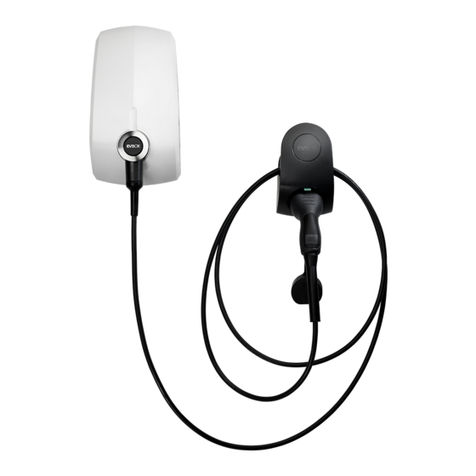
EVBox
EVBox Elvi Installation and user manual
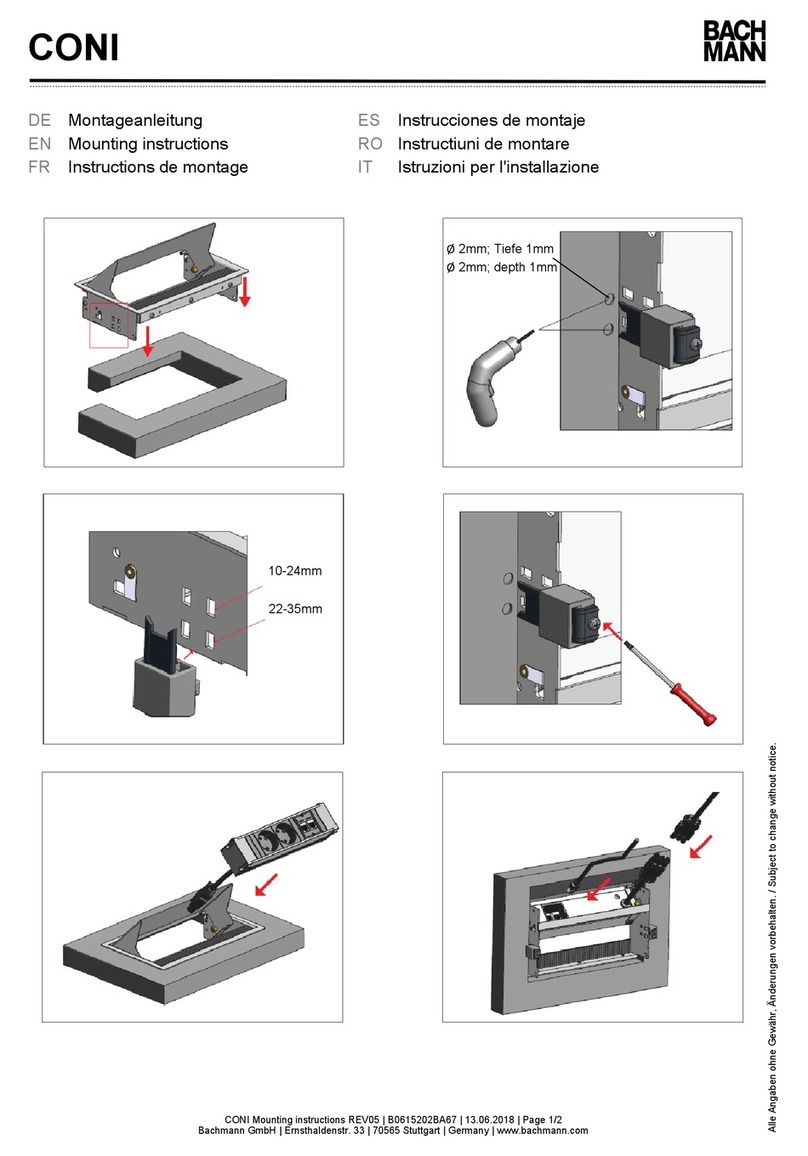
Bachmann
Bachmann CONI Mounting instructions

Kathrein
Kathrein UAS 585 manual
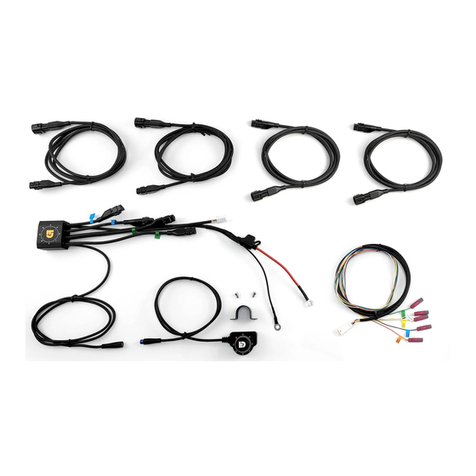
Denali
Denali DialDim DNL.WHS.20500 instruction manual
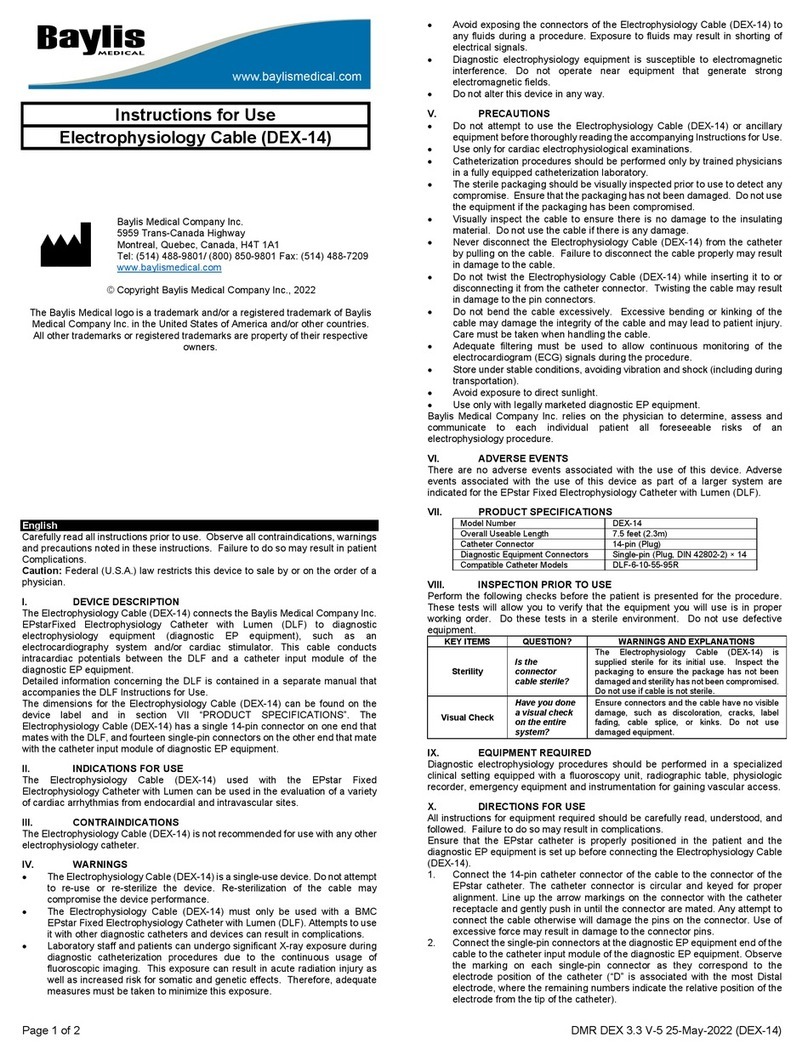
Baylis Medical
Baylis Medical DEX-14 Instructions for use

Gleason Reel
Gleason Reel Direct Drive Electric Cable Reels S-18 Installation and maintenance instructions

